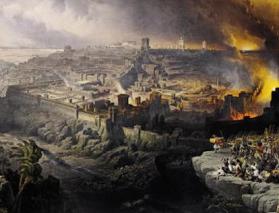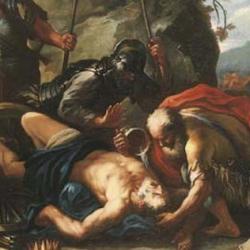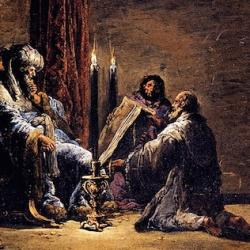Why does the Chronicler begin his narrative with Saul, and why with Saul’s death? As William Riley argues in his King and Cultus in Chronicles, the Saul narrative introduces topics that shadow the account of the Davidic kings. Specifically, the account of Saul’s death raises the question of the persistence of dynasties. Saul’s “whole house” falls at Mount Gilboa—not because every last descendant of Saul dies but because the death of the king and his three sons marks the end of the Saulide dynasty. This poses a question to the Davidic kings: Can David’s dynasty endure? If so, how?
Saul’s dynasty falls because he committed a transgression, a ma’al, and because he failed to seek Yahweh. Instead he “asked” after a medium (1 Chronicles 10:13–14), which is, as Riley points out, a pun on Saul’s name, sha’ul, the asked-for one. Saul not only turned from Yahweh. He effectively denied himself by asking for help in the wrong direction.
At the same time, Saul’s death casts doubt on Yahweh’s international reputation. The Philistines parade Saul’s head throughout Philistia, proclaiming the good news of their god Dagon. Finally, they place Saul’s head in Dagon’s house, a declaration of Dagon’s conquest of Yahweh’s anointed. If Yahweh doesn’t do something to reverse this, there is reason to question His authority over the nations.
David sets out to be the anti-Saul. Saul’s death scattered the tribes of Israel; David gathers (1 Chronicles 11:1–2). Saul didn’t seek Yahweh or His ark; David does (1 Chronicles 13). When David goes to battle against the Philistines, he “inquires” (sha’al) of Yahweh, proving himself to be the true Saul. Asking of Yahweh, David defeats the Philistines. David’s concern for the Lord’s ark and the building of the temple address the theological problem of Saul’s death: Yahweh is enthroned and exerts His power over Philistia. With David fighting His wars, His reputation is restored. At the same time, Yahweh promises David an enduring house (1 Chronicles 17), a dynasty that will not collapse as Saul’s did. The twin focus of the David narratives on temple and dynasty answer the questions posted by Saul’s death.
Formally, the Chronicler’s account of David is organized in something like a chiastic order:
A. Fall of Saul’s dynasty, ch. 10
B. David’s army, chs. 11–2
C. Transport of ark: Failure, ch. 13 (qahal, 13:2, 4)
D. War with Philistia, ch. 14
E. Ark into tent: Success, ch. 15
F. Psalm, ch. 16
E’. Build house? ch. 17
D’. Wars (framed by Philistia), chs. 18–20
C’. David’s census, ch. 21
B’. David’s administration, chs. 22–27
A’. David’s dynasty continues, chs. 28–29 (qahal, 28:8; 29:1, 10, 20 [2x])
It’s possible that the narrative is organized into two large chunks, chapters 10–21 and 22–29 respectively. If we worked with that assumption, we could see the parallels between Saul’s ma’al and David’s census, which is also a kind of sacrilege (though not called a ma’al). Still, the dynastic issues that are raised in 1 Chronicles 10 aren’t fully resolved until Saul is made king “a second time” in chapter 29. That suggests that the whole David narrative forms a large unity of Chronicles (though it is likely part of a larger unit that includes the Solomon narrative).
Some of the connections are more obvious than others, but the central section has a well-defined architecture. Wars frame sections dealing with Yahweh’s house and David’s, and the Psalm of the Levitical choir stands at the center. As often in Chronicles (see here and here), music is in the structural middle. Though this section of Chronicles is about the reign of Israel’s greatest king, the structure points to the real power of his reign: Song and music.
At the recent Biblical Horizons Summer Conference, it was suggested that the account of David generally follows the creation week. That makes theological sense: After the tohu w-bohu, the formless void at the end of Saul’s reign, Yahweh begins to form the world anew with David. Though this needs a great deal more elaboration, the overall creation sequence looks something like this:
1) David gathers warriors; the Spirit clothes Amasai to speak (1 Chronicles 11–12). Connection with Day 1 and Genesis 1:2.
2) David brings the ark to Zion and pitches a firmament tent to house it ( Chronicles 13–15). Day 2.
3) David sends away the people with raisins and bread (1 Chronicles 16:1–2), fruit and grains from Day 3.
4) David appoints Levites to sing around the ark, the stars who sing with morning and evening sacrifice (1 Chronicles 16). Day 4.
5) Day 5 is, as usual, obscure.
6) Yahweh promises David an enduring house, and David responds by saying that Yahweh has made him like “an adam ascended” (1 Chronicles 17). David goes on to fight wars in the power of Yahweh, like a new Adam (1 Chronicles 18–20).
7) David sins by taking a census (1 Chronicles 21). There is a “satan”; David succumbs to temptation; there is judgment with the angel of death wielding a sword, but also an atoning act of “covering.” It’s Genesis 3 over again, a seventh–day theme.
8) Unlike Saul’s dynasty, David’s dynasty doesn’t end with his sin. After the seventh-day fall, there is an eighth day of new life, as the atoning moment of chapter 21 gets expanded into a permanent system of atonement centered on the temple (1 Chronicles 22–29). With the plans for the temple in place, the new creation has come.















